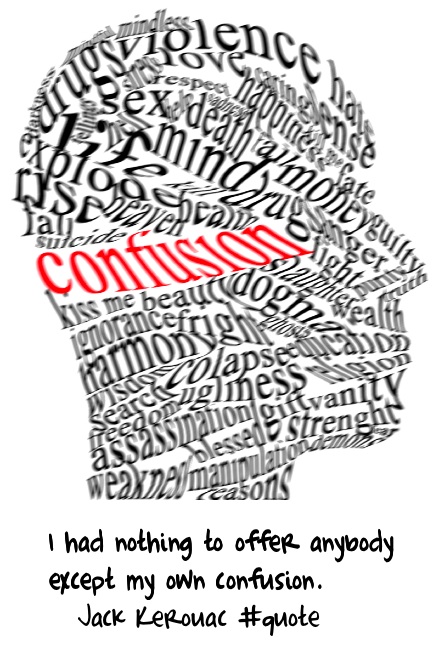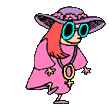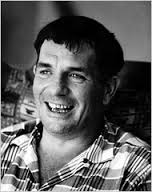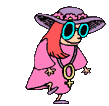









Beat Quotes
This is a good sized list of quotes by or pertaining to a beat author. Some of them are very deep, some of them all funny, and some make no sense whatsoever. Enjoy.
“There is no line between the ‘real world’ and ‘world of myth and symbol.’ Objects, sensations, hit with the impact of hallucination.”
-William Burroughs
“I’m running out of everything now. Out of veins, out of money.”
-William Burroughs
“Strip your psyche to the bare bones of spontaneous process, and you give yourself one chance in a thousand to make the Pass.”
-William Burroughs
“The charging restless mute unvoiced road keening in a seizure of tarpaulin power.”
-Jack Kerouac’s favorite line from On The Road
“Rather, I think one should write, as nearly as possible, as if he were the first person on earth and was humbly and sincerly putting on paper that which he saw and experienced and loved and lost; what his passing thoughts were and his sorrows and desires.”
-Neal Cassady to Jack Kerouac
“Americans should know the universe itself as a road, as many roads, as roads for traveling souls.”
-Walt Whitman
“Neal, we’ll be real heroes now in a war between our cocks and time: let’s be the angels of the world’s desire and take the world to bed with us before we die.”
-Allen Ginsberg to Cassady on their sexual relation…lines from the poem The Green Automobile
“If you have a choice of two things and can’t decide, take both.” -Gregory Corso “The stone world came to me, and said Flesh gives you an hour’s life.”
-Gregory Corso
“If you believe you’re a poet, then you’re saved.”
-Gregory Corso
“In such places as Greenwich Village, a menage-a-trois was completed- the bohemian and the juvenile delinquent came face-to-face with the Negro, and the hipster was a fact in American life.”
-Norman Mailer
“Madness is confusion of levels of fact…Madness is not seeing visions but confusing levels.”
-William Burroughs
“I really believe, or want to believe, really I am nuts, otherwise I’ll never be sane.”
-Allen Ginsberg to Jack Kerouac
“Sure I’m old, and I’m evil, and I’m ugly, and I’m tired. But that isn’t it. I’ve been this way for ten years, and I’m all down the main line.”
-Herbert Huncke to Allen GInsberg
“Neal will leave you in the cold anytime it’s in his interest.”
-LuAnne Cassady (the 15 year old bride of Neal Cassady)
“Oh, smell the people!’ yelled Dean with his face out the window, sniffling. ‘Ah, God! Life!'”
-Jack Kerouac, On The Road
“Obviously the ‘purpose’ of the trip is carefully selected to symbolize the basic fact of purposelessness. Neal is, of course, the very soul of the voyage into pure, abstract meaningless motion. He is The Mover, compulsive, dedicated, ready to sacrifice family, friends, even his very car itself to the necessity of moving from one place to another.”
-William Burroughs to Allen Ginsberg on Neal and his skeptical views of the man and voyage which spurred On The Road
“Love is all.’
-Jack Kerouac
“I went with him for no reason.”
-Jack Kerouac on Neal Cassady
“What’s your road, man? -holyboy road, madman road, rainbow road, guppy road, any road. It’s an anywhere road for anybody anyhow.”
-Neal Cassady as Dean Moriarty in On The Road
“Who are all these strange ghosts rooted to the silly little adventure of earth with me?”
-Jack Kerouac, on the final gathering/Snyders going away party
“The omlet fell apart, as with such eggs it must.”
-Wilifrid Sheed, on the San Francisco Renaissance Poets
“I am getting so far out one day I won’t come back at all.”
-William Burroughs
“Ginsby boy, he’s all over Oregon like horseshit howling his dirty pome.”
-Jack Kerouac on Allen Ginsberg
“I am beginning to think he is a great saint, a great saint concealed in a veneer of daemonism.”
-Jack Kerouac on Allen Ginsberg
“We are all trying to get the exact style of ouuselves.”
-Michael McClure on the San Francisco Renaissance
“To rebel! That is the immediate objective of poets! We can not wait and will not be held back…The “poetic marvelous” and the unconscious are the true inspirers of rebels and poets.”
-Philip Lamantia
“Around Jack there circulated a palpable aura of fame and death.”
-Gary Snyder on Jack Kerouac
“I want to create wilderness out of empire.”
-Gary Snyder
“I’m beat to the square, and square to the beat, and that’s my vocation.”
-William Everson aka Brother Antoninus
“We had gone beyond a point of no return- and we were ready for it, for a point of no return…We wanted voice and we wanted vision.”
-Michael McClure
“A reading is a kind of communion. The poet articulates the semi-known for the tribe.
-Gary Snyder
“I want your lingual SPONTINEITY or nothing else.”
-Jack Kerouac to Allen Ginsberg after reading Howl
“An army is an army against love.”
-Peter Orlovsky
“At that instant we looked into eachother’s eyes and there was a kind of celestial cold fire that crept over us and blazed up and illuminated the entire cafeteria and made it an eternal place.”
-Allen Ginsberg to William Burroughs on his new lover Peter Orlovsky
“I’ve been getting silly drunk again lately in Remo and discusting myself a la Subterraneans.”
-Jack Kerouac to William Burroughs
Jack Kerouac’s Translations of Buddhist Terms
Dharma: “truth law”
Nirvana: “blown-out-ness”
Tathata: “that which everything is”
Tathagata: “attainer to that which everything is”
Bodhisattva-Manasattvas: “beings of great wisdom”
“Kerouac’s version of Buddha is a dimestore incense burner, glowing and glowering sinisterly in the dark corner of a Beatnik pad and just thrilling the wits out of bad little girls.”
-Kenneth Rexroth
“I miss you so much your absence causes me, at times, accute pain. I don’t mean sexually. I mean in connection with my writing.”
-William Burroughs to Allen Ginsberg
“I did no think I was hooked on him like this. The withdrawl symptoms are worse than the Marker habit. Tell Allen I plead guilty to vampirism and other crimes against life. But I love him and nothing else cancels love.”
-William Burroughs to Jack Kerouac on Ginsberg
“I have a strange feeling here of being outside any social context.”
-William Burroughs in Tangiers
“Not that Irwin wasn’t worthy of him but how on earth could they consumate this great romantic love with vaseline and K.Y.?”
-Jack Kerouac on Ginsberg and Burroughs relationship
“Between incomprehensible and incoherent sits the madhouse. I am not in the madhouse.”
-Jack Kerouac to Carl Solomon.
“I think all writers write for an audience. There is no such thing as writing for yourself.”
-William Burroughs to Allen Ginsberg
“Usually he selected someone who could not reciprocate so that he was able-cautiously, like one who tests uncertain ice, though in this case the danger was not that the ice give way but that it might hold his weight-to shift the burden of not loving, of being unable to love, onto the partner.”
-Willam Burroughs on himself
“Avoid the world, it’s just a lot of dust and drag and means nothing in the end.”
-Jack Kerouac
“Al, I am a fucking saint, that is I been fucked by the Holy Ghost and knocked up with Immaculate Woid…I’m the third coming, me, and don’t know if I can do it again….so stand by for the Revelation.”
-William Burroughs to Allen Ginsberg
“Suffice to say I just eat every 12 hours, sleep every 20 hours, masturbate every 8 hours and otherwise just sit on the train and stare ahead without a thought…”
-Neal Cassady
“Wherever I go I see myself in a mirror- it used to be my own selfblood, now it is god’s.”
-Allen Ginsberg
“Never deny the voice- no, never forget it, don’t get lost mentally wandering in other spirit worlds or American or job worlds or advertising worlds or earth worlds.”
-Allen Ginsberg’s vow to himself
“I want to be a saint, a real saint while I am young, for there is so much work to do.”
-Allen Ginsberg to Mark Van Doren
“The apparition of an evil, sick unconscious wild city rose before me in visible semblance, and about the dead buildings in the barren air, the bodies of the soul that built the wonderland shuffled and stalked and stalked and lurched in attitudes of immemorial nightmare all around.”
-Allen Ginsberg (his visions after reading Blake)
“I was so sick that I found myself worrying about the future of man’s soul, my own in paticular.”
-Allen Ginsberg
“Just a little boy who wants to be a novelist.”
-Alan Ansen’s description of Jack Kerouac
“Death hovers over my pencil…”
-Jack Kerouac
Pinned to Jack Kerouac’s wall to inspire his writing: “Art is the highest task and the proper metaphysical activity of this life.”
-Nietzsche
“I am going to marry my novels and have little short stories for children.”
-Jack Kerouac
“The fact was I had the vision…I think everyone has…what we lack is the method.”
-Jack Kerouac to Allen Ginsberg
“I detest limitations of any kind, and intend to establish my ass some place where I am a virgin on the police blotter.”
-William Burroughs to Allen Ginsberg
“Naturally, I thought the guy was just kiddin.”
-Herbert Huncke, on Burrough’s request for a Viennese waltz
“Shooting is my principal pastime.”
-William Burroughs
“My fault, my failure, is not in the passions I have, but in my lack of control of them.”
-Jack Kerouac to Neal Cassady
“Two piercing eyes glancing into two piercing eyes- the holy con-man with the shining mind, and the sorrowful poetic con-man with the dark mind.”
-Kerouac on the night Ginsberg and Cassady met
“I really dont know how much I can be be satisfied to love you, I mean bodily, you know, I somehow dislike pricks & men & before you, had conciously forced myself to be homosexual…I dont want to be unconsciously insincere by passing over my non-queerness to please you.”
-Neal Cassady to Allen Ginsberg on their sexual relationship
“Dont you remember how you made me stop trembling in shame and drew me to you? Don’t you know what I felt then, as if you were a saint…?”
-Allen Ginsberg to Neal Cassady
“Neal is awareness, mine is conciousness. The conciousness is shallow, awareness is all embracing.”
-Allen Ginsberg on Neal Cassady
“He came to the door stark naked and it might have been the President knocking for all he cared. He received the world in the raw.”
-Jack Kerouac on Neal Cassady
“I have thought of Neal as being a psychopath for quite some time. To me he is nothing more than a series of incidents.”
-John Clellon Holmes to Ginsberg
“I see no greatness in my self…I’m a simple-minded, child-like, insipid sort of moronic and kind of akward feeling adolescent.”
-Neal Cassady on himself
“I became the unnatural son of a few score of beaten men.”
-Neal Cassady
“For Neal sex was the one and only holy and important thing in life.”
-Jack Kerouac on Neal Cassady
“Cassady was sexually initiated at the age of nine. He accompanied his father to the home of a drinking buddy, whose oldest son led his brother and Neal in sexual intercourse with as many sisters as they could hold down. All boundaries of sexual decorum evaporated. Neal “sneak shared” women with his father, he slept with grandmothers and prepubescent girls in abandoned buildings, barns, and public toilets.”
-Steven Watson, Birth of the Beat Generation
“I alone, as the sharer of their way of life, presented a replica of childhood.”
-Neal Cassady
Email: haesuse@aol.com
0.000000
0.000000
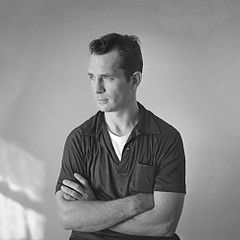 Jean-Louis “Jack” Lebris de Kerouac (play /ˈkɛruːæk/ or /ˈkɛrɵæk/; March 12, 1922 – October 21, 1969) was an American novelist and poet. He is considered a literary iconoclast and, alongside William S. Burroughs and Allen Ginsberg, a pioneer of the Beat Generation. Kerouac is recognized for his spontaneous method of writing, covering topics such as Catholic spirituality, jazz, promiscuity, Buddhism, drugs, poverty, and travel. His writings have inspired other writers, including Ken Kesey, Bob Dylan, Eddie Vedder, Richard Brautigan, Thomas Pynchon, Lester Bangs, Tom Robbins and Will Clarke. Kerouac became an underground celebrity and, with other beats, a progenitor of the Hippie movement, although he remained antagonistic toward it. In 1969, at age 47, Kerouac died from internal bleeding due to long-standing abuse of alcohol. Since his death Kerouac’s literary prestige has grown and several previously unseen works have been published. All of his books are in print today, among them: On the Road, Doctor Sax, The Dharma Bums, Mexico City Blues, The Subterraneans, Desolation Angels, Visions of Cody and Big Sur.
Jean-Louis “Jack” Lebris de Kerouac (play /ˈkɛruːæk/ or /ˈkɛrɵæk/; March 12, 1922 – October 21, 1969) was an American novelist and poet. He is considered a literary iconoclast and, alongside William S. Burroughs and Allen Ginsberg, a pioneer of the Beat Generation. Kerouac is recognized for his spontaneous method of writing, covering topics such as Catholic spirituality, jazz, promiscuity, Buddhism, drugs, poverty, and travel. His writings have inspired other writers, including Ken Kesey, Bob Dylan, Eddie Vedder, Richard Brautigan, Thomas Pynchon, Lester Bangs, Tom Robbins and Will Clarke. Kerouac became an underground celebrity and, with other beats, a progenitor of the Hippie movement, although he remained antagonistic toward it. In 1969, at age 47, Kerouac died from internal bleeding due to long-standing abuse of alcohol. Since his death Kerouac’s literary prestige has grown and several previously unseen works have been published. All of his books are in print today, among them: On the Road, Doctor Sax, The Dharma Bums, Mexico City Blues, The Subterraneans, Desolation Angels, Visions of Cody and Big Sur.